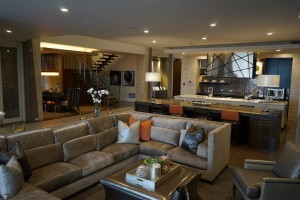Two Trails Inc. Green Building Consultants for NAHB 2014 New American Home and The 2015 New American Home.
The International Builders Show held this year in Las Vegas, Nevada February 4-6 is the building industry’s largest builder show. Two Trails Green Building Consultants was chosen to the be the Green Building consultants on this years home as well has been chosen to consult on next years home. The 2014 New American home featured Element Building Company as the builder, Jeffery Berkus Architects as the architectural firm and Marc Michaels Interior Design. The NAHB Leading Suppliers Council heads the showcase home. Vendors within the building industry come together to show their latest products and building techniques. This year’s home also features design concepts including multi-generational living, indoor-outdoor space, earth elemental tones, and energy efficiency.
As the NAHB’s official show home, The New American Home is a symbol of energy efficiency and innovation. The home exhibits cutting-edge products from manufacturers all over the world.
TNAH 2014 is designed to exceed the requirements for certification to the Emerald level of the National Green Building Standard™. Its energy-efficient features can be used in homes in a hot-dry climate at any price point with similar energy savings. The home is also certified Platinum under the United States Green Building Council (USGBC) LEED for Homes program, the EPA Energy Star program as well as the Indoor airPLUS program.
Two Trails, Inc. worked closely with NCHI to ensure energy efficiency and innovation in TNAH 2014. This home boasts a HERS Index of 22! It is expected to consume 78% less energy than if it were built to code (2009 IECC). At this level of energy efficiency, the home is designed to provide over $2,000 in annual energy savings to the homeowner.
The New American Home achieves a very high level of energy efficiency. The most noteworthy features of TNAH 2014 include the air tightness of its thermal shell and the use of solar energy. Under blower door testing, the thermal shell achieves 2.69 air changes at 50 Pa, an amount that is considered very airtight and keeps unwanted outdoor dry air from entering the home. Open-cell spray foam insulation is used on the inside of walls and underside of the roof deck, as well as around any penetrations, to prevent air leakage.
The home uses solar energy to power a portion of its electrical systems, space conditioning and hot water systems. The 16KW Photovoltaic (PV) system will provide approximately 83% of the annual energy needs for the home. A synchronized system of (4) Rannai natural gas-fueled tankless water heaters satisfies all of the hot water needs. The home also features both Natural Gas and Electric car charging stations in the Garage.
The systems-engineering approach unites segments of the building industry that have previously worked independently of one another.
The concept is simple: systems-engineering can make America’s homes cost effective to build or retrofit and energy efficient to live in. Energy consumption of new houses can be reduced by as much as 30% with little or no impact on the cost of construction. Similar performance can be achieved in existing homes.
To reach this goal, the Element Building team worked with their building partners to produce a home that incorporates energy and material saving strategies from design through construction. First, the team analyzed and selected cost-effective strategies for improving home performance. Next, the team evaluated design, business, and construction practices within individual partnerships to identify cost savings. Cost savings could then be reinvested to improve energy performance and product quality. For example, a design that incorporates new techniques for tightening the building envelope enabled Element Building to install smaller, less expensive heating and cooling systems. The savings generated in this process can then be reinvested in other high-performance features to further reduce energy use.
The “pilot” or “test” home is the field application of solution design. The team assisted Element Building in building TNAH according to strategic design, then tested each system for efficiency and made any necessary changes to increase efficiency and cost effectiveness. Before additional houses are built, these changes are incorporated into the design. This process of analysis, field implementation, reanalysis, and design alteration facilitates ultimate home performance once a design or retrofit strategy is ready for use in production or community-scale housing.
Understanding the interaction between each component in the home is paramount to the systems-engineering approach. Throughout design and construction, the relationship between building site, envelope, mechanical systems, and other factors is carefully considered. Recognizing that features of one component can dramatically affect the performance of others enables the Element Building team to engineer energy-saving strategies at little or no extra cost.
Two Trails is honored and proud to have been chosen to work on the 2014 New American Home. We look forward to next years NAHB International Builders show and to work with the Blue Heron Design and Build team for the 2015 New American Home.



